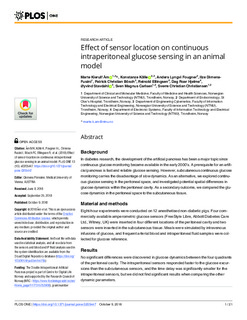| dc.contributor.author | Åm, Marte Kierulf | |
| dc.contributor.author | Kölle, Konstanze | |
| dc.contributor.author | Fougner, Anders Lyngvi | |
| dc.contributor.author | Dirnena-Fusini, Ilze | |
| dc.contributor.author | Bösch, Patrick Christian | |
| dc.contributor.author | Ellingsen, Reinold | |
| dc.contributor.author | Hjelme, Dag Roar | |
| dc.contributor.author | Stavdahl, Øyvind | |
| dc.contributor.author | Carlsen, Sven Magnus | |
| dc.contributor.author | Christiansen, Sverre | |
| dc.date.accessioned | 2019-03-28T09:58:28Z | |
| dc.date.available | 2019-03-28T09:58:28Z | |
| dc.date.created | 2018-09-28T13:39:38Z | |
| dc.date.issued | 2018 | |
| dc.identifier.citation | PLoS ONE. 2018, 13:e0205447 (10), 1-21. | nb_NO |
| dc.identifier.issn | 1932-6203 | |
| dc.identifier.uri | http://hdl.handle.net/11250/2592136 | |
| dc.description.abstract | In diabetes research, the development of the artificial pancreas has been a major topic since continuous glucose monitoring became available in the early 2000’s. A prerequisite for an artificial pancreas is fast and reliable glucose sensing. However, subcutaneous continuous glucose monitoring carries the disadvantage of slow dynamics. As an alternative, we explored continuous glucose sensing in the peritoneal space, and investigated potential spatial differences in glucose dynamics within the peritoneal cavity. As a secondary outcome, we compared the glucose dynamics in the peritoneal space to the subcutaneous tissue. Material and methods: Eight-hour experiments were conducted on 12 anesthetised non-diabetic pigs. Four commercially available amperometric glucose sensors (FreeStyle Libre, Abbott Diabetes Care Ltd., Witney, UK) were inserted in four different locations of the peritoneal cavity and two sensors were inserted in the subcutaneous tissue. Meals were simulated by intravenous infusions of glucose, and frequent arterial blood and intraperitoneal fluid samples were collected for glucose reference. Results: No significant differences were discovered in glucose dynamics between the four quadrants of the peritoneal cavity. The intraperitoneal sensors responded faster to the glucose excursions than the subcutaneous sensors, and the time delay was significantly smaller for the intraperitoneal sensors, but we did not find significant results when comparing the other dynamic parameters. | nb_NO |
| dc.language.iso | eng | nb_NO |
| dc.publisher | Public Library of Science | nb_NO |
| dc.relation.uri | https://doi.org/10.1371/journal.pone.0205447 | |
| dc.rights | Navngivelse 4.0 Internasjonal | * |
| dc.rights.uri | http://creativecommons.org/licenses/by/4.0/deed.no | * |
| dc.subject | Glukosemåling | nb_NO |
| dc.subject | Glucose sensing | nb_NO |
| dc.subject | Diabetes | nb_NO |
| dc.subject | Kunstig bukspyttkjertel | nb_NO |
| dc.subject | Artificial Pancreas | nb_NO |
| dc.title | Effect of sensor location on continuous intraperitoneal glucose sensing in an animal model | nb_NO |
| dc.type | Journal article | nb_NO |
| dc.type | Peer reviewed | nb_NO |
| dc.description.version | publishedVersion | nb_NO |
| dc.subject.nsi | VDP::Medisinske fag: 700 | nb_NO |
| dc.subject.nsi | VDP::Midical sciences: 700 | nb_NO |
| dc.source.pagenumber | 1-21 | nb_NO |
| dc.source.volume | 13:e0205447 | nb_NO |
| dc.source.journal | PLoS ONE | nb_NO |
| dc.source.issue | 10 | nb_NO |
| dc.identifier.doi | 10.1371/journal.pone.0205447 | |
| dc.identifier.cristin | 1615744 | |
| dc.relation.project | Norges forskningsråd: 248872 | nb_NO |
| dc.relation.project | Samarbeidsorganet mellom Helse Midt-Norge og NTNU: 2014/23166 | nb_NO |
| dc.description.localcode | © 2018 Åm et al. This is an open access article distributed under the terms of the Creative Commons Attribution License, which permits unrestricted use, distribution, and reproduction in any medium, provided the original author and source are credited. | nb_NO |
| cristin.unitcode | 194,65,15,0 | |
| cristin.unitcode | 194,63,25,0 | |
| cristin.unitcode | 194,63,35,0 | |
| cristin.unitname | Institutt for klinisk og molekylær medisin | |
| cristin.unitname | Institutt for teknisk kybernetikk | |
| cristin.unitname | Institutt for elektroniske systemer | |
| cristin.ispublished | true | |
| cristin.fulltext | original | |
| cristin.fulltext | postprint | |
| cristin.qualitycode | 1 | |

